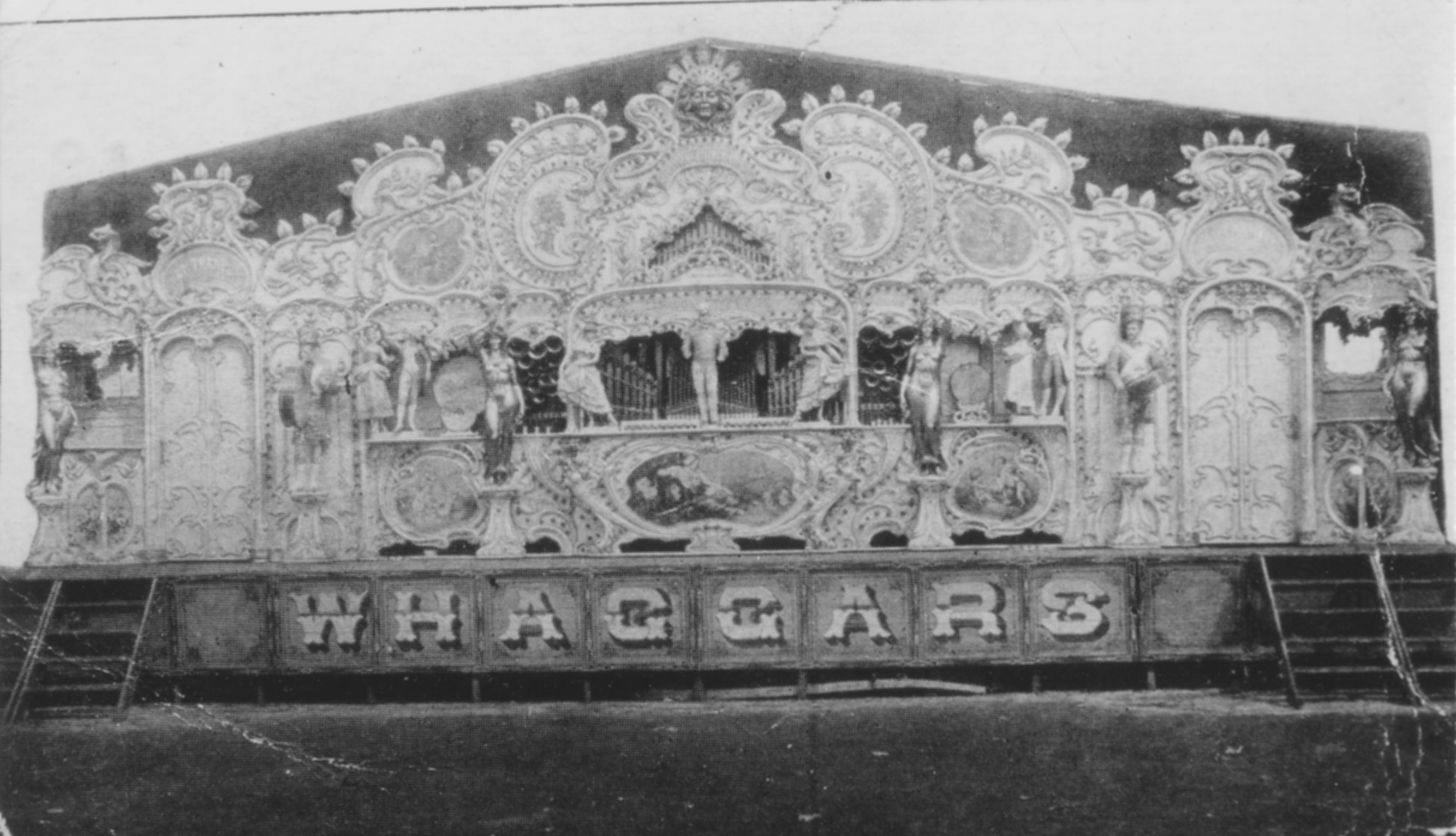William
Haggar, Fairground Film-Maker
The Book - "William Haggar, Fairground film-maker"
by Peter Yorke
Illegitimate son of an Essex housemaid. Docker, cornet-player,
stage-carpenter.
Comic actor. Portable Theatre proprietor. Amateur photographer.
Fairground showman.
Proprietor of Haggar's Royal Electric Bioscope. Pioneer film-maker.
Amusement Caterer.
Councillor and Guardian of the Poor. Charitable Philanthropist. "Dear
old William Haggar",
his memory would be "held in love and reverence by all".
These phrases describe the life of William Haggar (1851-1925), the
subject of his great-grandon's vivid biography. Born in Dedham, Essex,
William ran away from home. Learning to play the cornet, he got a job
as musician with a travelling theatre company.
In 1871 he married Sarah, an actress member of the "Inimitable Walton
Family" of
theatricals and pantomimists. Together they travelled for 38 years
through eastern England,
the West Country and South and West Wales "following the coal". By 1891
Sarah had had eleven children, eight of them surviving to adulthood.
Becoming the boss of his own theatre
company, William accumulated savings kept in gold under his mattress.
He blued £80 on
a primitive film projector worked by limelight, a hazardous mixture of
hydrogen and oxygen jetted onto a cone of lime. In April 1898, after
several experimental explosions, he and his sons Jim and Walter pushed
his first bioscope exhibition onto Aberavon fairground.
On the first day they took a massive £15, but the risky
enterprise nearly foundered on a six-month South Wales pit-strike which
deprived them of custom: they only narrowly survived.
By 1901 they had done well enough to buy a portable steam engine to
generate electric
light, but now William faced tough competition from showmen with other
attractions as
well as films. The supply of films was drying up and audiences were
bored with Rough Seas at Dover and Turnout of the London
Fire Brigade. Reacting by buying a movie-camera
and film stock, William began experimenting: as well as taking
'actuality' subjects
such as a train leaving Burry Port station, he tried his hand at a
first few 'made-up' fiction films, using the two family theatrical
companies' actors, plots and scenery: in 1902 he hit the jackpot with
these.
The Maid of Cefn Ydfa (Cefn Ydfa means 'back of the wheatfield',
the name of the Maid's house) was a romantic tragedy based on a novel
by Isaac Craigfryn Hughes, who had much embroidered a local tradition.
Now William filmed it in seven scenes, using his actress
daughter-in-law Jenny Lindon in the title role and her husband Will
Haggar Junior
as her lover Will Hopkins. Shot in an hour and a half and lasting six
minutes, the film was an instant success. It was said that "it brought
in hundreds and hundreds of pounds", and
that "when Haggar first put on The Maid, any opposition show
could close down".
During the next three years, William made The Poachers, a three
minute chase film which sold 470 copies, more than any other film. The
Sign of the Cross was the predecessor of Cecil B. de Mille's 1932
epic of the same name, famous for Empress Poppaea's bath
in asses' milk. The Life of Charles Peace, combining in ten
minutes the genres of drama
and chase, concludes with Peace's drop from the gallows: Walter Haggar,
playing Peace,
said later that he "had a very narrow escape from being choked to
death". In these films,
William introduced innovatory panning shots, camera placing and cutting
to produce
more immediate, less stage-bound films than many of his contemporaries.
He also made
short slapstick comedies, including the Mirthful Mary series,
in which an actress of
formidable stature and voluminous underwear lays waste snowballers, pub
drinkers, coppers
and magistrates - anti-authoritarian humour sure to appeal to his
fairground audiences;
and "hundreds" of short topical films, including fake newsreels of the
Boer and Russo-Japanese
wars, fought on the hills above Rhymney Valley. So well did this fare
go down that he
acquired three showman's traction engines and two huge ornate organ
showfronts brilliant
with coloured lights.
Sarah's death in 1909 persuaded William that it was time to settle
down. Buying suitable buildings and sites, he opened a chain of
cinemas. He was elected to the Merthyr Board
of Guardians and Aberdare Urban District Council. With Will and Jenny,
he made a third,
50-minute version of The Maid of Cefn Ydfa, longer than any
other film of the time made outside a film studio. First shown in
Aberdare in 1914 and reviewed in the South Wales
Echo in 1938 (a preface quotes the review), it was rediscovered in a
family cupboard in 1984
and conserved: 38 minutes survive. It is a superb record of an
Edwardian theatre company
performing its trademark play, wordless but enhanced by the greater
visual possibilities
of film. William's last years were spent in honoured retirement. He
died in February 1925.
He had said there would be money in it and he was right: he left
£16,912 - perhaps a million and a half today.
The story unfolds in ten chapters, the last relating the rediscovery
and recognition of the
pioneering quality of William's eight surviving films. The author's
grandmother, Violet
Haggar, led the paraders, the "bevy of beauties in short skirts
gracefully throwing
their nether limbs about" before the show to attract customers: his
Haggar relatives'
reminiscences amd memoirs are combined to produce first-hand accounts
of the events described. A family tree is included. Illustrations from
the time, interspersed with the text, include portraits of the family
in theatrical costume, the showfronts and
stills from the films: the titles of seventy Haggar films are listed
and sales catalogue
synopses quoted for thirty of them. Press articles on the opening of
William's Kosy Kinema
in 1916 and William as a "Man at the Wheel" in 1924 and his obituaries
are quoted in full.
Notes give references to sources. There are full Indices. This book is
a "must" for all those interested in the popular entertainment of 100
years ago.
Picture: Showfront

